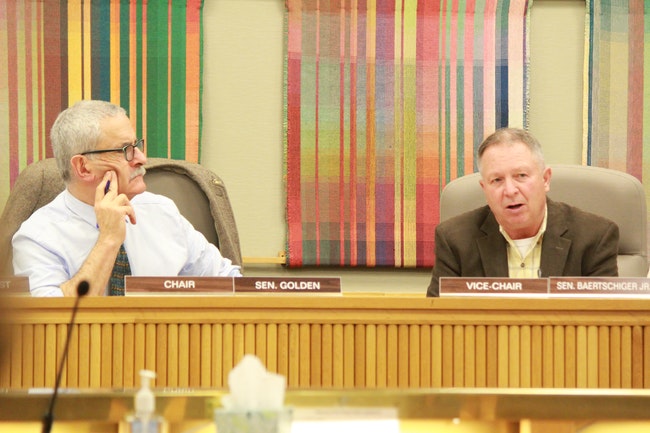
Sen. Jeff Golden and Sen. Herman Baertschiger, chair and vice chair of the Senate Committee on Wildfire Response, have differing views of a new state timber deal. (Sam Stites/Oregon Capital Bureau)
SALEM – The deal announced last week was intended to end the war in the woods that has beset Oregon forestry issues for decades.
But not everyone is cheering what Gov. Kate Brown described as a “historic” deal between timber firms and environmentalists. The critics suspect something is more at play than the pursuit of peace.
Some characterize the agreement signed by members of the Oregon Forest & Industries Council and a coalition of environmental groups as the first step in healing, but it also has bearing on a much broader discussions in the Capitol, particularly over climate change.
“There are people who had the rug pulled out from under them 30 years ago, and they never really recovered,” said Sen. Jeff Golden. “That makes what we’re trying to do with the climate bill hard for them to accept. It’s interesting that all this is coming together at the same time, the question for those of us with a gavel is how to make the most of it.”
The opening came after representatives of the timber industry reached out to Brown and sat down for a meeting with her staff on Jan. 9. They requested that the governor moderate a discussion between industry leaders and the environmental community on moving forward as partners rather than adversaries.
The governor agreed, mediating four meetings from Monday, Jan. 27 to Wednesday, Feb. 5 in Portland and in Salem. Representatives from both sides aired long-standing grievances, explained their views and then considered how they might proceed together.
What emerged was a memorandum of agreement signed by 13 of the most reputable Oregon companies and organizations on either side of the debate. It also means both sides will drop dueling sets of proposed ballot initiatives which seemed destined for an expensive clash in November 2020.
The agreement — somewhere between a handshake deal and legally-binding agreement — incorporates three key pieces.
The first outlines that the two sides will come together to create a habitat conservation plan that rules over 30 million acres of public and private timberlands throughout the state, protecting endangered species and updating timber practices.
The second calls for all parties to support legislation to protect forest watersheds by restricting aerial spraying of pesticides and herbicides. The bill also outlines implementation of a state-of-the-art system to notify neighbors of aerial spraying.
Lastly, it widens buffer zones for streams within the Rogue-Siskiyou region of southern Oregon. New legislation also would expand stream buffers along salmon, steelhead, and bull trout streams to bring forest practices into line with the rest of western Oregon. The deal is predicated on the idea that both sides agreeing to what is the best science to use for decisions.
Agreeing to the deal were Hampton Lumber, Weyerhaueser, Roseburg Forest Products, Seneca Sawmill Company, Hancock Natural Resource Group, Stimson Lumber, Greenwood Resources, Campbell Global, Pope Resources, Port Blakely and the Oregon Small Woodlands Association.
In the environmental camp, Oregon Wild, Wild Salmon Center, Oregon Stream Protection Coalition, Beyond Toxics, Audubon Society of Portland, Cascadia Wildlands, Klamath Siskiyou Wildlands Center, Pacific Coast Federation of Fishermen’s Associations, Trout Unlimited, Northwest Guides and Anglers Association and the Oregon League of Conservation voters all signed.
According to Casey Roscoe, vice president for public affairs for Seneca, this agreement is a step to see if there’s a shared vision between the two sides for the future of forest practices which accounts for sustainability and Oregon’s ecosystem. She’s cautiously optimistic that this deal represents a fresh start for both sides.
“That vision is of healthy trees. It’s of thriving wildlife. It’s of cool, clean water and world class recreation. It’s of renewable building materials and other wood products,” Roscoe said. “That is our vision. What we’re hoping is perhaps that can be their vision too, and if that’s true, if we do have, in fact, shared vision, then maybe we can come to the table and talk about how to make that happen and work toward it, because we’re all on the same planet.”
Bob Rees, executive director of the Northwest Guides and Anglers Association, said that the deal shows good faith by the timber industry to hear out conservationists.
“The pesticide application on these lands and waterways is of course of great concern to us, the real punch in the MOU is if the timber interests agreed to formulate this habitat conservation plan that’s on the table,” Rees said. “It’s a good thing, and the science is already developed, but we haven’t implemented these practices on state or private lands.”
Rees recalled when he started as a professional fishing guide in 1996 and fishermen were allowed to catch five of the six species of salmonids in the rivers of Oregon’s north coast. Over time, with warming temperatures and rising levels of dissolved oxygen, the list of endangered species slowly grew and depleted runs of every type of salmon, crippling the state’s fishing industry.
“If the negotiations are successful, it really shows an effort by private landowners to recognize the value of other natural resources other than timber that their lands harbor,” Rees said.
Jim James, executive director of the Oregon Small Woodlands Association, is one of the sponsors of the three initiatives from the timber industry that will be set aside now.
“The real benefit is that we’re getting the opportunity to sit down and talk with each other to find a compromise,” James said.
But not everyone is feeling as hopeful as those directly involved in the deal.
Republicans in the Legislature criticize the deal for putting them in a less stable position around the discussion of Oregon’s proposed greenhouse gas reduction bill, Senate Bill 1530.
On Thursday, Senate Republican Leader Herman Baertschiger, Jr., R-Grants Pass, went on the “Lars Larson Show” to denounce the deal, saying it made his life more complicated.
“What they basically said is, if you want your timber industry’s pesticide bill to pass, you’re going to have to stick around for cap-and-trade, and we simply can’t do that,” Baertschiger told Larson. “The timber industry didn’t do us any favor. I don’t know who is advising them politically, but I’d give them their walking papers.”
That would be Greg Miller of the Oregon Forest Industries Council, who said that the deal is a shared recognition between the timber industry and conservation groups of the diverse benefits Oregon’s forests provide and the need for more meaningful efforts on forest issues.
Baertschiger has characterized the deal as big corporate timber selling out to Oregon’s Democratic supermajority and hurting the state’s smaller timber interests.
James, representing woodland owners, feels otherwise.
“My perception is that if we can get to the compromise and stop the wars, it would be beneficial to every forest landowner in Oregon,” he said. “Often times folks try to separate the family landowner from the forest products industry, but there’s a reality that family woodland owners need a strong forest products industry so when they harvest, they have value.”
The next step in moving toward final solidification of this deal is passing new laws on aerial spraying of pesticides. The deal hinges on passage of House Bill 4109, which prohibits spraying of pesticides containing the chemical chlorpyrifos within 300 feet of a school and requires employers to keep workers from entering areas where it was sprayed for up to eight days. The bill was passed out of the House committee on health care Thursday, Feb. 13, in a 7-4 party-line vote.
According to committee chair Rep. Andrea Salinas, D-Lake Oswego, the bill is important to public health and she’s confident the House will approve it.
“With the number of colleagues that I’ve spoken with, I think they understand that this does need to be looked at from a public health lens,” she said. “There are certain times when the Legislature, on behalf of the people, we need to step in.”
Contact Reporter Sam Stites: [email protected] or 971-255-2480.




